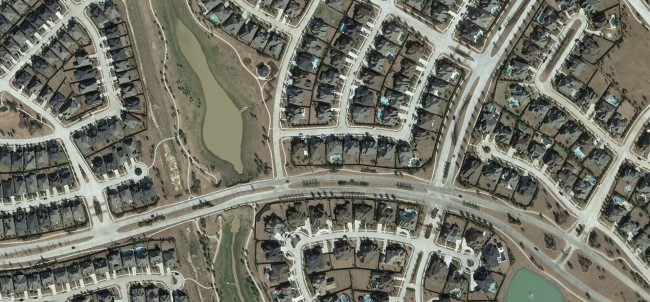Downtown Houston gives a false impression of the city it represents. In fact, for the past couple of decades, Downtown has experienced the opposite of the rest of the region: while the city’s population has practically exploded and the metro has become a haven for both mega-corporations and immigrants seeking to flush money into a prosperous resource-driven economy, the Central Business District has stagnated and rotted. Whatever vitality that colored the city in the 1940s – before the Interstate Highway System – has fled to the suburbs. Downtown’s Manhattanized street grid, once filled to the brim with business, is now a high-density relic in a sea of dozens of no-density surface parking lots. Sure, a cluster of attractive award-winning skyscrapers continues to fuel Houston’s national image, but behind that facade is a disappointing story of extreme suburbanization and long-wasted opportunity.
Unfortunately, the story of Downtown Houston is not unfamiliar to many other Sunbelt cities across the country. For many places, urbanism simply ceased to exist for most of the latter half of the 20th century – and the more extreme the rate of growth, the more devastating the impact on the traditional city center. Houston’s economic boom in the late 1970s was nothing short of insane. The region built and then overbuilt, spreading the suburbs to their geographic extremes and sapping the Inner Loop dry of wealth. There are many lessons to be learned from Houston’s poor planning during this time period – and many of the city’s most troubled districts are a direct result of a failure to accommodate any sense of foresight into the region’s growth (not that I don’t have some forgiveness for the leaders at the time, any city would get overly excited about that sort of economic opportunity). I could go on extensively about the garden apartment problem, the food deserts, the suburbs lost in time… but the focus is on Downtown, which is quickly (and thankfully) seeing its fortunes change.
The primary theme of urban development for the 20th century was suburbanization. In the 21st, it will be reurbanization. The suburbs have been ousted as an inefficient and undesirable form of land-use policy. Their propagation has created a society where most are forced to become dependent on homes that are isolated, cheaply built and expensive to occupy (especially when transportation costs are taken into account). These cookie-cutter developments lack a sense of community and force individuals to rely on their vehicles – and the traffic that they create – to have any sort of life whatsoever. This is especially prevalent in Houston, where thousands upon thousands are forced to endure grueling rush hour traffic, accidents ranging from inconvenient to deadly, and psychological degradation that breeds road rage and stress.
The most recent development boom has seen a sudden reinvestment in Houston’s densest districts – Downtown, Midtown, Montrose, Upper Kirby and Uptown. After decades of development being focused almost exclusively on suburban tracts at the edge of the metropolitan area, traditional density has become fashionable again. Indeed, this animation is especially useful at portraying the sea change:

Residential is fast approaching the Downtown core. Indeed, this is in no small part due to efforts by the municipal government, especially a new residential incentive that provides a hefty per-unit discount to developers who construct apartments in the city center. However, supplanting surface parking lots and derelict warehouses with new upper-class residential projects is a tall order. A lot of additional efforts will have to be undertaken to ensure the success of any sort of revitalization vision for Downtown. At the moment, the city center simply isn’t poised to take full advantage of pro-development economic conditions. Downtown lacks grocery stores and basic retail (barber shops, dry cleaners and the like) amongst other things. And, of course, the oversupply of surface parking lots severely detracts from the district’s walkability.
It can be safely assumed that, with time, the basic residential amenities that Downtown lacks will come with the new development. However, if the City of Houston truly wants to turn the CBD from a really big office park into a bustling high-density neighborhood, it’ll have to take some significant initiative. Over the next few months, I’ll present a number of ideas that I feel could help turn Downtown into a mixed-use gem. These include:
- Establishing dedicated retail and shopping districts that provide a true walkable experience.
- Beautifying traditional vehicular entrances to Downtown, especially on the northside of the district.
- De-spaghettifying and rebuilding the freeway infrastructure that surrounds Downtown as well as mitigating the impact of these concrete monoliths on inter-neighborhood transportation and interaction.
- Turning the stretch of the Buffalo Bayou that traverses Downtown into a unique asset to the city.
Houston is among America’s next generation of great cities. However, our lack of a proper urban core – or the mixed-use amenities that Americans are increasingly demanding – will only work to our detriment. What does it mean when Houston is considered one of the most ugly and pedestrian unfriendly cities in the nation? It means this city become unattractive to the newcomers that fuel its economy. And while most outside of Texas far overexaggerate Houston’s negative attributes (and often completely ignore its positive qualities), it’s still important that this city emphasize the availability of a lifestyle that isn’t rooted in the suburbs – an urban approach to city living which is quickly becoming the norm across the nation. Houston should be a city where both the urbanist and suburbanist can live in harmony. A reinvigorated Downtown will go a long way to making that a reality.

